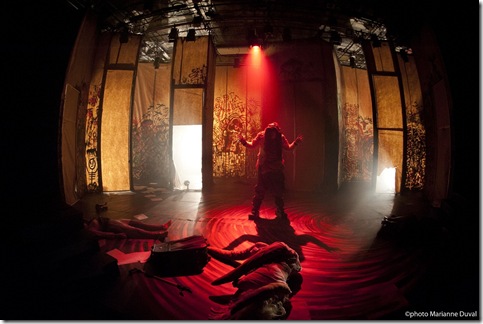La Charge de l’orignal épormyable: blood curdling production of this Claude Gauvreau play on the U. of Ottawa stage.
Photo. Marianne Duval.
A blood curdling all feminine production of La Charge de l’Orignal Épormyable, under the direction of Guy Beausoleil, plays this week at the U.of Otttawa . This is a rare chance to see a work by Claude Gauvreau, poet and playwright, who was one of the people who signed the Quebec Manifesto Refus Global in 1948 and set Quebec culture on a new trajectory.
This plays gives us an excellent glimpse of the poet, his tortured conscience, his vision of artistic production and his heightened idea of the poet who emerges as a god, a super presence that can save the world. We see, among other things how his dialogue, becomes a verbal form of “Automatismse”, essentially a reference to the visual art experiments of the period. , Gauvrau wrote partially in “ langue exploréenne”. Portions of his text represent “non figurative” language composed of extra-linguistice elements (sound, rhythm, accents, ) that corresponded (in spoken language) to the Automatist experiments in non-figuratuve painting in the 1950s where the sexual impulse was considered central to artistic creation. Most of those who signed the Manifesto Refus Global were removed from their jobs and became pariahs of society because it appeared that most of the artistic establishment in postwar Quebec was not yet ready to accept a form of “Modernité” that was inherited from the new European art Movements.
The play has ups and downs as far as the staging is concerned but the cruel rituals of psychiatric torture by a group of sado masochistic psychotherapists with twisted masks and witch-like faces is orchestrated by Guy Beausoleil with a lot of energy and wild flare. The very first scene however appears to go way over the top from the very beginning because their gyrations and overacting makes it difficult to distinguish the meanings in the text. This high level of collective physical intervention at the very outset created much confusion and did not allow the play nor the collective performances of the psychiatrists to evolve quite as they might have have although the text shows very clearly how the sado masichistic relationship between the “professionals” and the Poet becomes uglier and more cruel. They want him to die and they skillfully manipulate the situation, subjecting him to psychiatric “tests” and mind altering drugs which confuse and weaken him, thus contributing to his own death even though he struggles to retain his lucidity. That moment of the final “charge” might have been given more emphasis some way because it was that final ironic death blow that was never intended but that did the deed by bursting open his head!
Gauvreau creates here a metaphor for Quebec of the 1940’s and 50s , to suggest the way that society excluded and destroyed its artists. It is also full of biographical references, bu alluding, for example to the fact that Gauvreau had to undergo shock treatment in the 1950’s that was performed in a terribly violent scene with the blood-curdling killer “Cromagnon”, sporting the mane of a lion!!
Some of actors were particuarly strong : Amélie Duguay as Dydrame Daduve was a nontwisted, calm and beautiful presence who brings calm to this tortured poet; Alexandra Poblete as Mycroft Miceudeim the tortured poet seemed uncomfortable at first but in her monologues became stronger and the meaning poured through that difficult language with whihc she seemed to connect. Stephanie Mazunya was a particularly viscious, statuesque, seductive and sadistic Letasse Cromagnon who kills with great panache! A fine actress whom we would like to see more often on stage.
Director Guy Beausoleil had the courage to undertake this text with such a young and female cas. Normally the main roles are performed by males, but it still worked well from the gender perspective. The set and use of sound were particularly important and well done, even the ear peircing shreik that opens the show , brings in the first “charge” and rattles your head for the rest of the evening, becomes pure Theatre of Cruelty for those of us who had to listen to it. No doubt about it that the University of Ottawa theatre department (working in both languages) is producing the most interesting texts and the most daring stagings that we can see in Ottawa these days.
A difficult but important work that all students of Quebec theater and francophone literatures should see.
La Charge de l’orignal épormyable plays at the Universitiy of Ottawa Theatre department: 8pm It runs until this Saturday, March 28.
